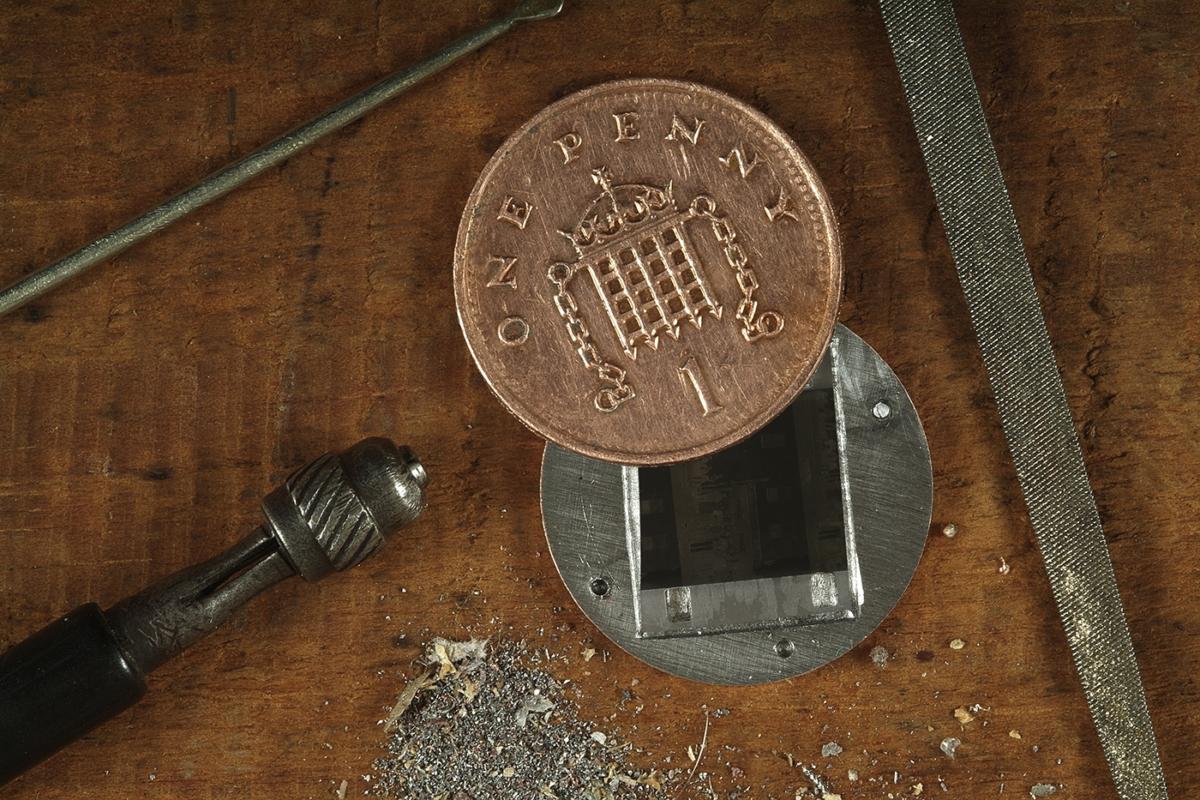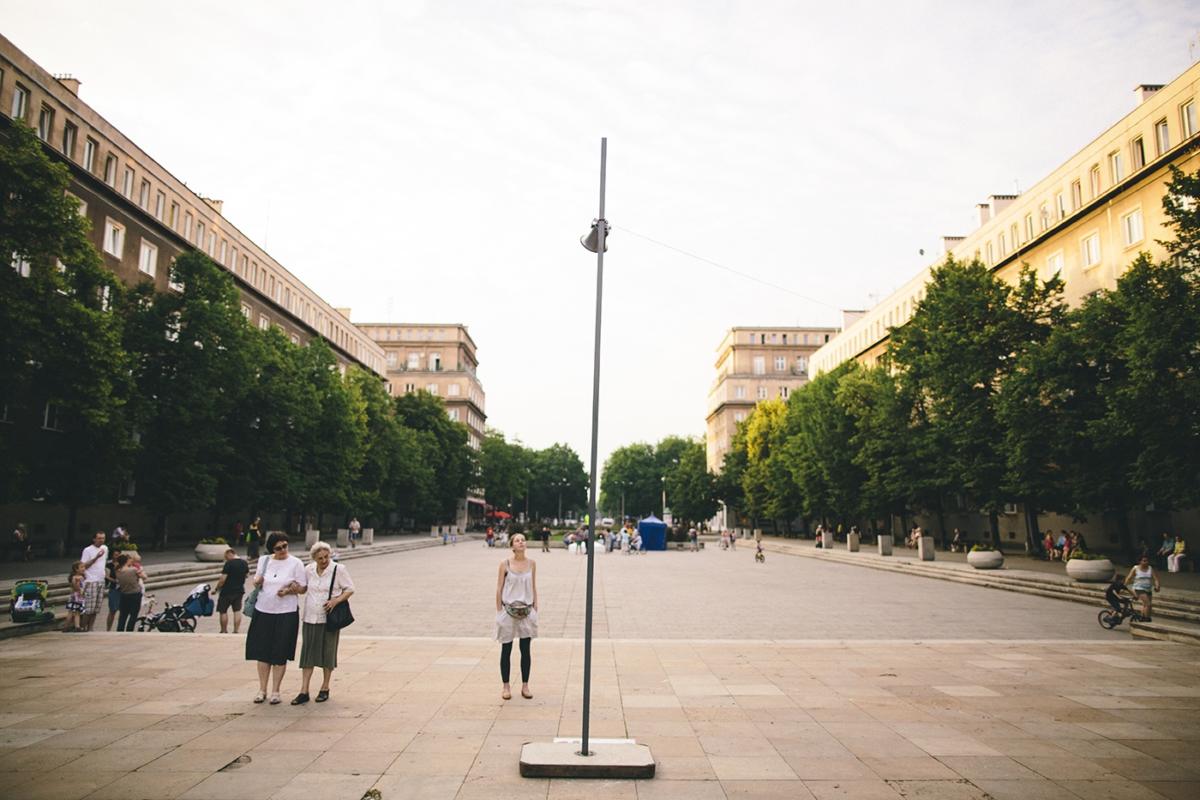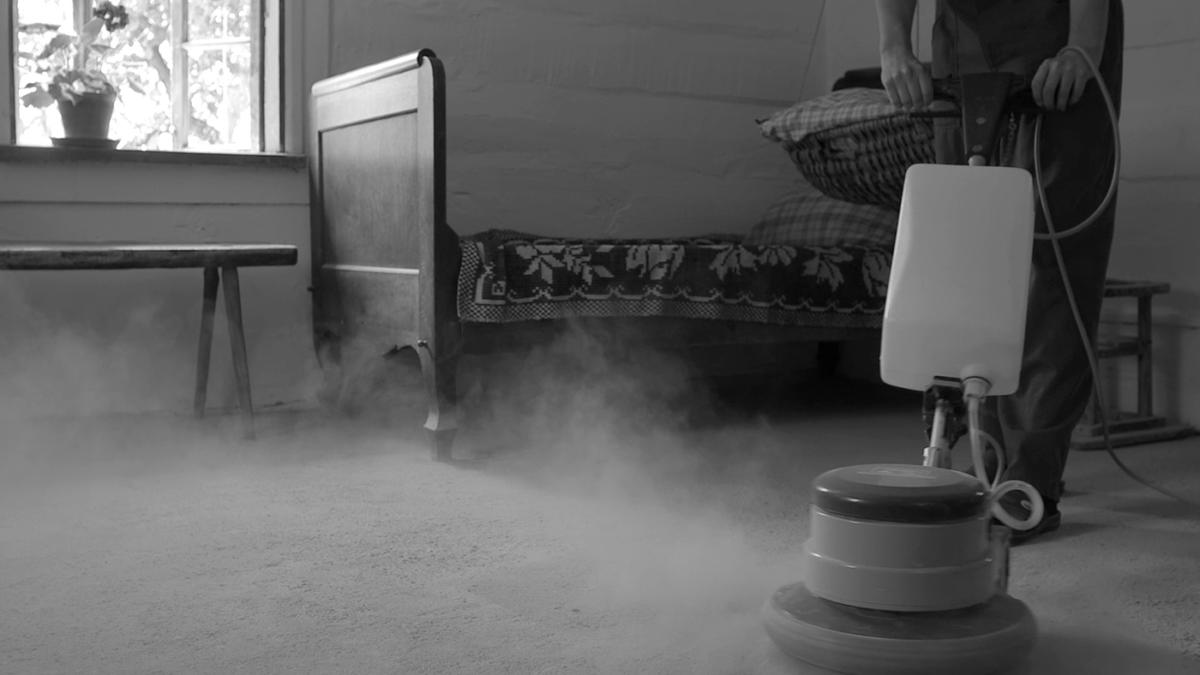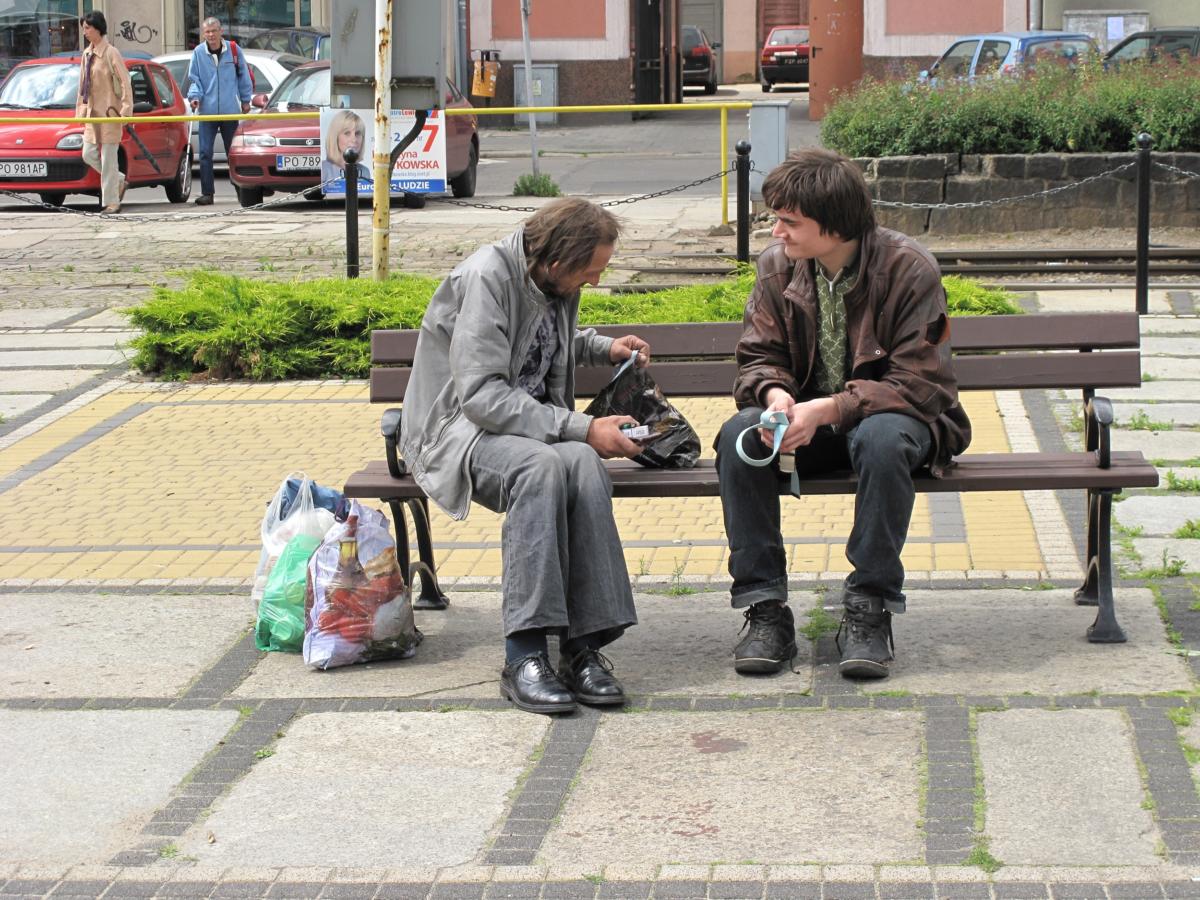
The artist as a collector of signs of the present and the globalist turn
In several of his artworks, Franciszek Orłowski’s interventions go beyond an aesthetic understanding, and include topics, or references to situations, persons, and problems that are connected to the social context in which he works, and at the same time connect to the global reflection on topics such as immigration, the effects of the economic crisis, and the memory of the recent past. In what follows, I will explore the context in which we might situate the artworks of Franciszek Orłowski from the analytical perspective offered by the interdisciplinary field of “art and politics” and, at the same time, link it to the global turn in contemporary art. As several art critics and theoreticians have observed, contemporary art has had the tendency in the last decades to confront issues that are no longer national, or specific to a country, but which are, on the contrary, global.
“I looked at the man warmheartedly with love as I put on his pants and underwear smelling of urine, sweat, dirt… smelling of his life, actually… He took what had been mine, and I took what was left of him.”
In an essay titled “Peripheries of the World, Unite!,” Piotr Piotrowski argues for “a non-hierarchical art-historical analysis on a global scale” or a “horizontal analysis” for which “one has to select several key dates and examine artworks that were created during those times in different parts of the world. In particular, one must focus on artworks that were created in the context of important events or even helped bring them about.”[1] Piotrowski also recalls Hans Belting’s conceptualization of global art, which has a “post-historic and post-ethnic character, the tendency to be collective rather than individual in nature, its glocal […] orientation, its critical impulse and alter-globalist concerns, and its media-based character.”[2] Supporting Belting’s approach, Piotrowski claims that global art, and the tendency to construct a new discourse, is most strongly seen in the peripheries.[3] Piotrowski thus argues in favor of what he calls utopistics, that is, a project which would “include studies of the artistic peripheries of the world and art history that are based on a comparative and horizontal methodology, studies of geo-historical margins and marginalized cultures of the East and Global South.”[4]
According to art critics such as Rex Butler, global art, the “globalist style” or globalism is the new dominant trend of contemporary art, whether in its preferred topics or its modes of articulation.[5] Globalist artworks could be defined by their inherent self-criticism or self-contradiction, the “excuse for doing what it does lies in the way that it does not see itself as outside of the problems it depicts but as part of them.” Fredric Jameson in his essay “Globalization as a Philosophical Issue” stresses the problem of characterizing globalization: either as a homogenizing force or one based on stressing difference, as they both seem to be at its core.[6] In this sense, the work of Franciszek Orłowski asks new questions and brings in new possibilities involving the issue of difference, and how different or similar we are, especially in relation to his corpus of artworks that deal with homeless people.
Nicolas Bourriaud contends that the successor to postmodernism should be “altermodernity,” which “corresponds to the globalized world order, a modernity ‘born of global and decentralized negotiations, of multiple discussions among participants from different cultures’ in which ‘the immigrant, the exile, the tourist, and the urban wanderer are the dominant figures of contemporary culture.’”[7] Thus, “the global network becomes a space of exchange, of diverse representations of the world, in which translation of ideas and representations places a crucial role in ‘discussions that will give rise to a new common intelligibility.’”[8] Furthermore, Jacques Rancière contends the political role of art is not that which might seem obvious from the articulation of a political stance by the artist, but one which allows the artist to have a political discourse through the artistic gesture itself. Thus, for Rancière, the artist is a collector of signs, an archivist of the real that surrounds him. It is in this sense that, in the work of Franciszek Orłowski, we can see several political issues, among them the exclusion of the other, which can be observed in the artist’s highlighting of the homeless (Kiss of Love, 2008–2009; Project “0”, 2010–2011; Fitting Room, 2012; Doorway Curtain, 2013; Skin and Bones, 2013); of immigrants (Small Change, 2010; This Blood is for You, 2016–2018); and of topics tied to the politics of memory (Study of Memory, 2014; Old Brown Bear is Sleeping Soundly, 2014). The analysis of these artworks will connect Orłowski’s approach to these themes to other artworks realized in the last decades, or which are currently being realized in countries across the world, from Poland to Chile.
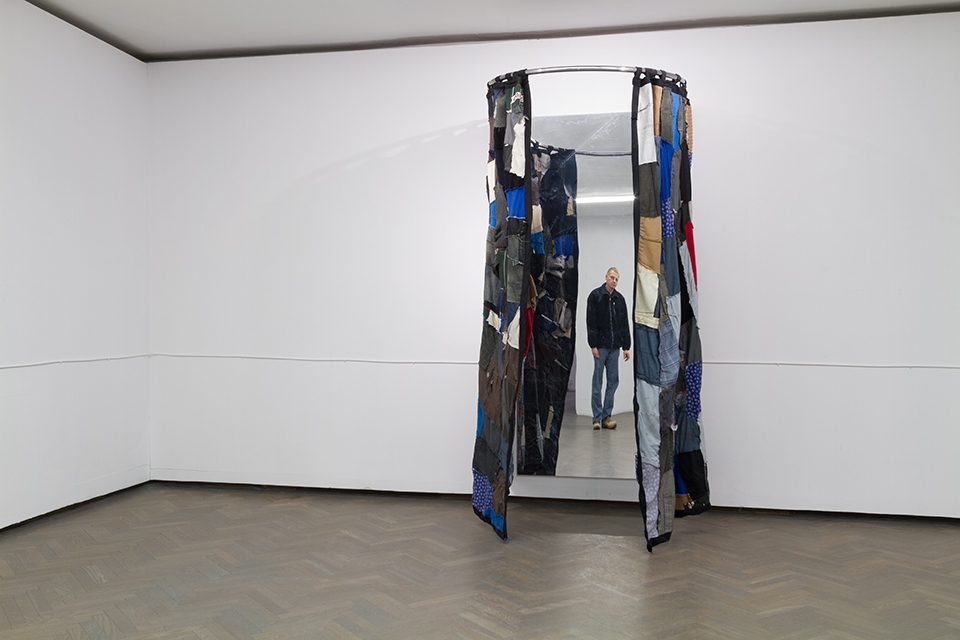

The Kiss of Love: The marginal as “the (invisible) other” and a transregional perspective
In Kiss of Love (2008–2009), Franciszek Orłowski worked with homeless men in Poznan, questioning the marginality and otherness of these people by switching roles with them. The artist would exchange clothes and personal items with the homeless men and allow for an exchange of perspectives, underlining the tentative character of our own positions. The clothes collected by the artist in these exchanges were used in subsequent artworks in the series.
The artist stitched together the homeless people’s clothes in: Project “0”, Fitting Room, Skin and Bones, and in Doorway Curtain. In each of the artworks, the clothes were included in a display inside the gallery. In Project “0” (2010–2011) the artist takes the clothes he received through his exchange in the Kiss of Love and sews them into a tent that preserves the smells of their initial owners. As the artist recalls: “I looked at the man warmheartedly with love as I put on his pants and underwear smelling of urine, sweat, dirt… smelling of his life, actually… He took what had been mine, and I took what was left of him.”[9] The artist suggests how this exchange, literally taking the other’s “shell” and walking in his shoes, enables us to assume a different perspective and feel empathy towards the “other.” In Fitting Room (2012), the artist made a dressing room out of the same collected clothes, adding a mirror and a semicircular curtain rod. The visitor can thus enter the fitting room, and the title itself evokes the possibility of “trying on” the real from the perspective of the excluded “other.” In Doorway Curtain (2013), visitors entering the gallery must push aside a curtain sewn from scraps of the homeless people’s clothing.
One way of understanding Orłowski’s corpus of art dealing with his exchange with homeless people is to connect it to artworks about the lives of those invisible to the majority, a global population of individuals who, at some point in time, end up living on the streets. People living on the streets and at the margins of society have been a constant preoccupation of several contemporary artists, including Boris Mikhailov, Krzysztof Wodiczko, Michael Rakowitz, Paz Errázuriz, Virginia Lupu, and Diamela Eltit. Boris Mikhailov is best known for having immortalized the homeless people left behind by the de-Sovietization of Ukraine. In his series Case History (1997–1998), Mikhailov made portraits of people found at the margins of ex-Soviet society. These homeless individuals are shown as extremely raw hypostases that don’t convey any of the photographer’s empathy. Rather, the viewer is confronted with their difficult circumstances without any beacon of hope. The individuals are often depicted without clothes; they appear to be drunk or under the influence of drugs; they laugh, and we can see their destitution. As has been noted, Mikhailov often paid his subjects, and thus a certain sense of performance for the camera permeates all his photographs.
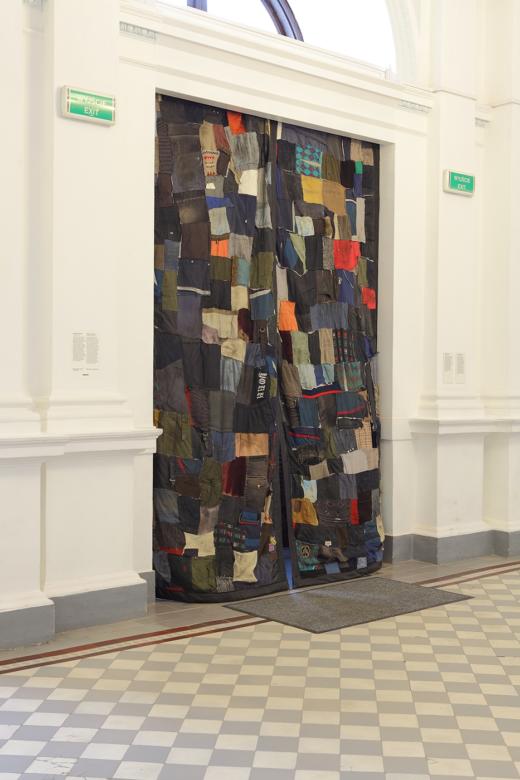
Franciszek Orłowski, ‘Doorway Curtain’ 2013, patchwork, textiles
These portraits can find a parallel in the photographs taken by the Chilean artist Paz Errázuriz. In her series Heart Attack of the Soul (1992–1994), Errázuriz documented the faces and the romantic relationships of another marginal group, the psychiatric patients of the hospital in Putaendo. The exact opposite of Mikhailov’s photographic series, the pictures taken by Errázuriz capture the poetics of love and madness, but also look upon her subjects with empathy. In other photo series such as Sleepers (1979), she depicts people sleeping in the streets, on the sidewalk, and on public benches, in circumstances that are looked at with compassion. Moreover, in other portraits, such as those in the series Adam’s Apple (1982–1987), about male-to-female cross-dressing prostitutes in Santiago, and in photos such as Friends (1987), which shows three poor men sharing a moment of happiness in the streets of Santiago, laughing together with arms around each other’s necks, Errázuriz registers humanity in its different forms.
The work of the Romanian documentary photographer Virginia Lupu combines the two approaches of Mikhailov and Errázuriz. Lupu takes pictures of destitute people or marginalized individuals who live at the periphery of society, including the transsexual sex workers with whom she lived in order to shed light on their lives. In his Homeless Vehicle Project (1988–1989), Krzysztof Wodiczko developed provisional accommodation for people living in the streets, creating mobile homes in which their owners could sleep. From 1987 to 1989, Wodiczko worked with people living in the streets to create a device that could help them. Another example of this approach, one that involves inventing a temporary solution to homelessness, is the piece by Michael Rakowitz, ParaSITE Homeless Shelter (1997), which resulted from the artist’s collaboration with homeless people who told him about their needs. Rakowitz created inflatable shelters that could be connected to the heating or ventilation ducts of buildings, thus providing a temporary solution to their situation.
Orłowski’s Kiss of Love also draws an interesting parallel to an action by the Chilean artist Diamela Eltit, a member of Escena de Avanzada. In the sixteen-minute video piece Zona de Dolor I [Pain Zone I] (1980), the artist goes to a brothel, where she cuts her body and reads parts of her novel Lumpérica, afterwards washing the pavement in front of the establishment. In the second part of this art intervention, Zona de Dolor II [Pain Zone II], also known as Trabajo de amor con un asilado de la Hospedería de Santiago, or El Beso (1982), the artist kissed a homeless man. “Eltit was interested how such homeless and unsheltered lives wander freely, slipping away from the production system, lives whose private acts turn into spectacle. […] Eltit explored marginal worlds, distancing herself from her social class and from acceptable relations and attempting to move close to that distant other from her place as a white woman.”[10]
While other artists discussed here address the topic of homelessness or those living on the margins of society through art that merely depicts the problem, as in the case of Mikhailov and Errázuriz, or offers a temporary solution, in the cases of Wodiczko and Rakowitz, Orłowski’s pieces use the exchange as an opportunity to invite collaboration from the people with whom he interacts, as is the case with the artwork of Diamela Eltit.
Immigration: the common ground
Recent years have brought about a global reflection about the impact of immigration caused by conflicts and inequality. Several artists have addressed the immigration crisis. One of the most active in this regard has been the Chinese artist Ai Weiwei, whose works have been highly criticized for their sometimes exaggerated or “obscene” highlighting of the situation of migrants. In his recent New York exhibition Good Fences Make Good Neighbors (2017), he installed fences in several locations throughout the city. In his earlier action Fairytale (2007), he took 1,001 Chinese citizens to Documenta, documenting their journey and visit. After recreating the famous image of the child Alan Kurdi, who drowned in Turkey in September 2015, the artist installed 14,000 life jackets from Lesbos (used by some of the 450,000 refugees) on the pillars of the Berlin Konzerthaus. The Cuban artist Tania Bruguera worked extensively with the topic of immigrants in the large-scale project Immigrant Movement International (2011) in which she imagined “an artist-initiated socio-political movement.” The artist “examined growing concerns about the political representation and conditions facing immigrants” and “delved into the implementation of art in society, examining what it means to create ‘Useful Art.’”[11]
We could therefore consider Franciszek’s practice in this broader context of contemporary art that is interested in the issue of migration. Small Change (2010) is one of the artworks by Orłowski that deals with the immigration of Polish citizens. In this piece, realized in London, the artist took a photograph of a place called “the wailing wall,” known among Polish immigrants as a place where one can find a job. A microfilm copy of this image was subsequently inserted into a one-penny coin and put into circulation. The art action documents this process in five slides. The artwork evokes the reality of an immigrant’s life and the circulation of coins – and the ephemeral presence of the two elements – in the same place. In This Blood is for You (2016–2018), Orłowski took documentary photographs of people from different countries whom he asked to donate blood to a Polish blood bank. The images show a Syrian, a Colombian, a Belorussian and a Ukrainian donating blood in an anonymous gesture, one which is only registered by the artist as such. The donors are shown in protective clothing such as that used in hospitals, and they are smiling, thus underscoring the voluntary aspect of the human gesture that is blood donation. This is a very interesting piece, considering the increasingly unwelcoming stance towards immigrants seen in Europe in recent years. It puts forward humanity and the equality of the blood we share, which represents life.
[…] the work of Franciszek Orłowski asks new questions and brings in new possibilities involving the issue of difference, and how different or similar we are, especially in relation to his corpus of artworks that deal with homeless people.
There are several other ways to deal with the topic of migration. For example, in the video recording of the action La ropa sucia se lava en casa [Dirty laundry must be washed at home] (2017), the Chilean artist Máximo Corvalán-Pincheira washes 31 items of clothing donated by immigrants living in Santiago, bleaching the garments until they lose their color. The artist thus stresses the changes a person must undergo to adapt to a new country, and he used clothes to emphasize this process of transformation. In the video entitled When I work I miss them, when I sleep also I miss them (2015), its title taken from a statement by the Bangladeshi worker Zakir Hussain, the Romanian duo Mona Vătămanu and Florin Tudor show workers toiling in the dark, revealing only brief glimpses of what they are building. For the artists, Hussain’s “words resume the situation of millions of migrant workers who traveled for long distances in order to provide living money for the families back home.”[12]
Whenever Orłowski’s work addresses migration, the context he brings into the discussion involves laborers emigrating from Poland, as well as people from other parts of the world coming to the country. It is thought provoking to see these opposing images of migration to and from Poland meet in his artistic discussion of the issue.
The politics of memory practices in post-communist Central and Eastern Europe
After the fall of the communist regimes in Central and Eastern Europe, and while societies tried to move on and to forget the past, several cultural and artistic practices registered the need to address certain aspects of these recent experiences. In this sense, we could discuss examples of contemporary art and visual practices that constitute a corpus of the “art of memorialization.” These practices of artistic remembrance examine the symbols of the past as symptoms of the need to nuance our understanding of that past, or criticize the official stance of governments, which privileged forgetting over remembrance.
Artists have used the symbol of the statue of Lenin to discuss the relationship to the communist past, as in the case of Project 1990 (2010–2014), curated by Ioana Ciocan in Bucharest, which featured different artists who placed new artworks on or around the pedestal vacated by the removal of a statue, with the majority of these pieces bearing a connection to the communist past and its aftermath. Lenin also appeared in the Wolfgang Becker film Good Bye, Lenin! (2003), in which the removed statue is flown over Berlin, and Ulysses’ Gaze (1995) by Theo Angelopoulos, which shows Lenin lying on his back as he is shipped down the Danube. Lenin left, but the Lithuanian artist Deimantas Narkevičius chose to replace statue on its plinth in Once in the XX Century (2004).
Born in 1984, before the fall of communism in Poland, Franciszek Orłowski is a privileged witness of the transformation of a society from communism to post-communism. It is in this sense that we could discuss his artworks that deal with practices of memory. The piece Study of Memory (2014) is a video recording of an action that took place in an open-air museum that portrays life in nineteenth and early-twentieth-century Polish villages using replicas of wooden houses, along with other characteristic buildings. The piece depicts work carried out by a cleaning company, which “must have a certificate of the EU” for its operations and which, through their cleaning processes, removes “the epidermis associated with traces of time.” As we observe the cleaner going through the motions, we see how the memory of the place is being reworked through a mechanical gesture.
Whenever Orłowski’s work addresses migration, the context he brings into the discussion involves laborers emigrating from Poland, as well as people from other parts of the world coming to the country. It is thought provoking to see these opposing images of migration to and from Poland meet in his artistic discussion of the issue.
Old Brown Bear is Sleeping Soundly (2014) is an art intervention by Orłowski in which he used a popular children’s song to create a sound installation. As the artist recalls: “Generations of Polish children used to sing this song at a game in which one child played the bear, crouching in the middle and pretending to be asleep. Other participants stood around him singing. When the song came to an end, ‘the Old Brown Bear’ chased other children trying to catch someone to replace him. The song was sung to the tune of ‘You had, boor, a golden horn’ from Stanisław Wyspiański’s drama Wesele [The Wedding].”[13] The sound installation was placed in the Nowa Huta neighborhood of Krakow, in which a Lenin statue stood until 1989. The statue itself was replaced and reworked after 1990.[14] The memory of the neighborhood, which was begun in 1949 as a model socialist town, later becoming part of the city of Krakow, resonates in this artwork, which uses sounds of the past that are familiar to those who lived during those times. Nowa Huta was intended to be an ideal socialist city inhabited mostly by industrial workers employed by one of the largest steel mills in Poland. The aftermath of this socialist plan is the present lived by the artist, which he shares with his fellow citizens.
Orłowski’s pieces that deal with practices of memory can thus be placed in a larger corpus of artworks in Eastern and Central Europe which grapple with the remnants of a past that will not pass. Those artworks that include poetic references, such as the sound of music from his childhood, re-washing the past with a modern machine, can be thought of in relation to the work of other artists in the region and elsewhere.
The artist as a mediator of transregional social and political problems
In this short essay, I have examined how Franciszek Orłowski’s creations can relate to a broader corpus of artworks that deal with global topics such homelessness, marginality, and the migration issue, or with regional themes such as post-communist memory. In doing so, I attempted to stress the common substance and attention of contemporary artistic practices that are interested in socio-political themes.
In this analysis, I focused on several transregional threads that can be traced among the artworks created by Franciszek Orłowski and those of other artists working in the former Soviet and ex-communist space, as well as those authored by artists in South America. In line with Piotr Piotrowski’s perspective on art made in the peripheries of the East and Global South as holding the potential to construct a new understanding of reality as conceived by artists working in these margins, I analyzed how Orłowski’s artworks can shed a different light these topics. As part of the negotiations that constitute the common intelligibility shared by a “global network” (Bourriaud), Orłowski’s artworks advance the possibility of going beyond representation. This is obvious in pieces that are based on his interactions with homeless people, and which incite transformation through an exchange that emphasizes the impermanence of the difference between the artist and those living in the street, without permanent shelter, as urban wanderers.
Finally, in agreement with the Rancièrian perspective I proposed, Franciszek Orłowski’s art is also involve in the collection of signs of the real, as in the pieces that deal with the plight of immigrants, and in ones that confront the issue of memory, allowing him to advance a different understanding of his context.
The text first appeared in Work for Small Change by Franciszek Orłowski, edited by Magdalena Radomska. Published by Zamek Ujazdowski Centre for Contemporary Art.
[1] Piotr Piotrowski, “Peripheries of the World, Unite!,” in: Extending the Dialogue. Essays by Igor Zabel Award Laureates, Grand Recipients, and Jury Members, 2008–2014, IZA Editions, Ljubljana 2016, p. 16.
[2] Ibid, p. 25.
[3] Ibid, p. 24.
[4] Ibid, p. 26.
[5] Rex W. Butler, “The world is not enough: Art and globalization”, ArtUS, 2008, Vol. 21. Further considerations can be found in Jonathan Harris, The Utopian Globalists: Artists of Worldwide Revolution, 1919–2009, Wiley-Blackwell, Chichester 2013.
[6] Fredric Jameson, “Notes on Globalization as a Philosophical Issue,” in: The Cultures of Globalization, ed. Fredric Jameson, Masao Miyoshi, Duke University Press, Durham 1998, pp. 54–76.
[7] Nicolas Bourriaud, The Radicant, Lukas & Steinberg, New York 2009. Quoted after John Potts, “The Theme of Displacement in Contemporary Art,” E-rea, 2012, No 9.2, https://journals.openedition.org/erea/2475.
[8] Ibid.
[9] Franciszek Orłowski, [Portfolio], Poznan 2015, p. 11. (All references in this text are to the Franciszek Orłowski’s 2015 portfolio, which is unpaginated. The numbers refer to the page of the PDF document.)
[10] Andrea Giunta, “Poetics of resistance,” in: Radical Women: Latin American Art, 1960–1985, ed. Cecilia Fajardo-Hill, Andrea Giunta, Hammer Museum & DelMonico Books/Prestel Publishing, Los Angeles 2017, pp. 251–259.
[11] The description of the project can be found on the website: www.taniabruguera.com/cms/486-0-Immigrant+Movement+International.htm.
[12] The description of the project can be found on the website: www.monavatamanuflorintudor.ro/theendoftheworkingday.htm.
[13] Franciszek Orłowski, [Portfolio], Poznan 2015, p. 54.
[14] In 2014 newspapers registered the installation of a small yellow monument of Lenin pissing in the Nowa Huta neighborhood. Called Fountain of the Future by artists Bartosz Szydłowski and Małgorzata Szydłowska, it was installed as part of Krakow’s 6th Grolsch ArtBoom Festival.
Imprint
| Author | Magdalena Radomska (editor) |
| Artist | Franciszek Orłowski |
| Title | Work for Small Change |
| Publisher | Zamek Ujazdowski Centre for Contemporary Art |
| Published | 2018 Warsaw |
| Index | Caterina Preda Franciszek Orłowski Ujazdowski Castle Centre for Contemporary Art |

